-
> Pedr09
> MPCII - Melach ah Uziel Orh Egel έ Klein II ןיילק ה לגא רוא לאיזוא הא ךאלמ
> School of Life
> Sience
> Physics
Particle Could Be Portal to Fifth Dimension. Dark matter could be the result of fermions pushed into a warped fifth dimension.This theory builds on an idea first stated in 1999, but is unique in its findings.Dark matter makes up 75 percent of matter but has never been observed ... yet.

In a new study, scientists say they can explain dark matter by positing a particle that links to a fifth dimension. While the “warped extra dimension” (WED) is a trademark of a popular physics model first introduced in 1999, this research, published in The European Physical Journal C, is the first to cohesively use the theory to explain the long-lasting dark matter problem within particle physics.
Our knowledge of the physical universe relies on the idea of dark matter, which takes up the vast majority of matter in the universe.
'Glitch in the Matrix' Film Review: Trippy Doc Questions Nature of Reality. Director Rodney Ascher’s specialty is obsession, but his approach succeeds as compassion.

After giving voice to people consumed by “The Shining” (“Room 237”), ventriloquist dummies (“The Wooden Boy”) and sleep paralysis (“The Nightmare”), he’s shifted his attention to simulation theory with “Glitch in the Matrix,” premiering at Sundance just before it goes into wider release. A subject tailor-made for college, festival and midnight audiences, simulation theory questions human determination by positing that we are merely avatars, and that some greater force — an external gamer, if you will — is our master manipulator.
Much of this concept comes directly from sci-fi writer Philip K. Dick, who is copiously represented throughout “Glitch.”
Researchers observe what could be the first hints of dark bosons. Extremely light and weakly interacting particles may play a crucial role in cosmology and in the ongoing search for dark matter.
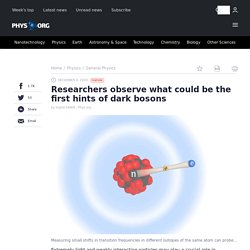
Unfortunately, however, these particles have so far proved very difficult to detect using existing high-energy colliders. Researchers worldwide have thus been trying to develop alternative technologies and methods that could enable the detection of these particles. Over the past few years, collaborations between particle and atomic physicists working at different institutes worldwide have led to the development of a new technique that could be used to detect interactions between very light bosons and neutrons or electrons.
Titanium atom that exists in two places at once in crystal to blame for unusual phenomenon. The crystalline solid BaTiS3 (barium titanium sulfide) is terrible at conducting heat, and it turns out that a wayward titanium atom that exists in two places at the same time is to blame.

The discovery, made by researchers from Caltech, USC, and the Department of Energy's Oak Ridge National Laboratory (ORNL), was published on November 27 in the journal Nature Communications. It provides a fundamental atomic-level insight into an unusual thermal property that has been observed in several materials. The work is of particular interest to researchers who are exploring the potential use of crystalline solids with poor thermal conductivity in thermoelectric applications, in which heat is directly converted into electric energy and vice versa.
Crystals are usually good at conducting heat. By definition, their atomic structure is highly organized, which allows atomic vibrations—heat—to flow through them as a wave.
Jupiter and Saturn to align in the sky this month as 'Christmas Star'
Article Seen in this photograph is the beautiful spiral arm of our galaxy; stars of the constellation Libra, constellation Scorpius, Planet Jupiter (Bright Spot at the Center) & Majestic Saturn at 8 o'clock of Jupiter.

This photo was taken at Varasgaon d The two largest planets in the solar system, Jupiter and Saturn, have fascinated astronomers for hundreds of years. But the two gas giants will do something next month not seen since the Middle Ages -- they will look like a double planet. The rare occurrence will happen after sunset on Dec. 21, 2020, the start of the winter solstice.
Jupiter and Saturn will come within 0.1 degrees of each other, forming the first visible "double planet" in 800 years. Before 2020 comes to a close, Jupiter and Saturn will be so close that they will appear to form a "double planet.

" The great conjunction, as the planetary alignment has come to be known, hasn't occurred in nearly 800 years. When their orbits align every 20 years, Jupiter and Saturn get extremely close to one another. This occurs because Jupiter orbits the sun every 12 years, while Saturn's orbit takes 30 years — every couple of decades, Saturn is lapped by Jupiter, according to NASA.
Light is a wave - Recherche Google. Light is a wave - Búsqueda de Google. Light is a wave. En.m.wikipedia. Propagating spacetime ripple Simulation of the collision of two black holes.
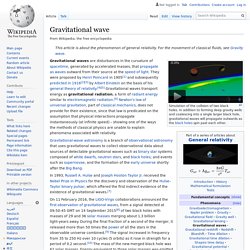
In addition to forming deep gravity wells and coalescing into a single larger black hole, gravitational waves will propagate outwards as the black holes spin past each other. Gravitational waves are disturbances in the curvature of spacetime, generated by accelerated masses, that propagate as waves outward from their source at the speed of light. Gravitational-wave astronomy is a branch of observational astronomy that uses gravitational waves to collect observational data about sources of detectable gravitational waves such as binary star systems composed of white dwarfs, neutron stars, and black holes; and events such as supernovae, and the formation of the early universe shortly after the Big Bang.
Ligo-gravitational-waves-black-holes-einstein.amp. A team of scientists announced on Thursday that they had heard and recorded the sound of two black holes colliding a billion light-years away, a fleeting chirp that fulfilled the last prediction of Einstein’s general theory of relativity.
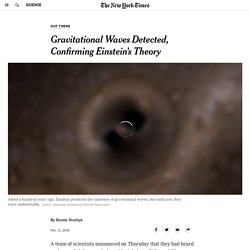
That faint rising tone, physicists say, is the first direct evidence of gravitational waves, the ripples in the fabric of space-time that Einstein predicted a century ago. (Listen to it here.) It completes his vision of a universe in which space and time are interwoven and dynamic, able to stretch, shrink and jiggle.
Spaceplace.nasa. The Short Answer: A gravitational wave is an invisible (yet incredibly fast) ripple in space.
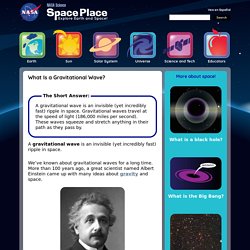
Gravitational waves travel at the speed of light (186,000 miles per second). These waves squeeze and stretch anything in their path as they pass by. A gravitational wave is an invisible (yet incredibly fast) ripple in space. We’ve known about gravitational waves for a long time. Albert Einstein, official 1921 Nobel Prize in Physics photograph.
Www.nature. Astronomers observed 39 cosmic events that released gravitational waves over a 6-month period in 2019 — a rate of more than one per week.
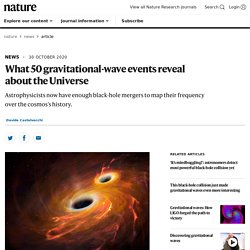
The bounty, described in a series of papers published on 28 October1,2,3, demonstrates how observatories that detect these ripples — usually created by the merging of two black holes — have dramatically increased their sensitivity since the first identification was made in 2015. The growing data set is helping astronomers to map how frequently such events have happened in the Universe’s history.
Www.sciencemag. Less than 5 years ago, physicists rocked the scientific world when they first spotted gravitational waves—fleeting ripples in space and time—set off when two gargantuan black holes billions of light-years away swirled into each other. Since then, scientists have detected a scad of similar events, mostly reported event by event. Today, however, researchers with a global network of gravitational wave detectors announced the first major statistical analyses of their data so far, 50 events in all. Posted online in four papers, the analyses show that black holes—ghostly ultraintense gravitational fields left behind when massive stars collapse—are both more common and stranger than expected.
39988-black-hole-mysteries-stephen-hawking. There's a lot we still don't know about black holes, but these light-gobbling behemoths would be even more mysterious if Stephen Hawking hadn't plumbed their inky depths. For starters, the famed cosmologist, who died yesterday (March 14) at the age of 76, helped give more solid mathematical backing to the concept of black holes, the existence of which was predicted by Albert Einstein's 1915 theory of general relativity.
"Hawking actually proved some rigorous mathematical theorems about Einstein's equations for gravity that showed that, under quite general circumstances, there were places where the equations broke down — what are called singularities," said Tom Banks, a professor of physics and astronomy at Rutgers University-New Brunswick in New Jersey.
"And, in particular, the region inside of a black hole is such a singularity.
" [Stephen Hawking: A Physics Icon Remembered in Photos]
#:~:text=Hawking's%20theory%20suggested%20that%20the,to%20%E2%80%9Cthe%20information%20paradox%E2%80%9D. Professor Stephen Hawking dedicated much of his career to unravelling the mysteries of black holes, and now the final chapter of his research on the “information paradox” is online. Days before his death in March, aged 76, the renowned physicist and cosmologist completed work with colleagues at Cambridge and Harvard universities on a theory of what happens to the information in objects that fall into black holes. Malcolm Perry, a professor of theoretical physics at the University of Cambridge and a co-author on the paper, Black Hole Entropy and Soft Hair, said in the Guardian that the information paradox was “at the centre of Hawking’s life” for more than 40 years.
The ‘information paradox’ Building on the foundations laid by Albert Einstein in his groundbreaking theory of relativity, Hawking used quantum theory to contend that in the cold depths of space black holes emit heat and slowly contract until they no longer exist. Shedding light on the universe License and Republishing. #:~:text=An%20electromagnetic%20%E2%80%9Cblack%20hole%E2%80%9D%20that,built%20for%20the%20first%20time.&text=Their%20idea%20was%20to%20mimic,space%2Dtime%20and%20spiral%20inwards.
By Anil Ananthaswamy (Image: Qiang Cheng and Tie Jun Cui) An electromagnetic “black hole” that sucks in surrounding light has been built for the first time. The device, which works at microwave frequencies, may soon be extended to trap visible light, leading to an entirely new way of harvesting solar energy to generate electricity. A theoretical design for a table-top black hole to trap light was proposed in a paper published earlier this year by Evgenii Narimanov and Alexander Kildishev of Purdue University in West Lafayette, Indiana.
Their idea was to mimic the properties of a cosmological black hole, whose intense gravity bends the surrounding space-time, causing any nearby matter or radiation to follow the warped space-time and spiral inwards.
Scientists succeed in measuring electron spin qubit without demolishing it. Unraveling turbulence: New insights into how fluids transform from order to disorder. Turbulence is everywhere—it rattles our planes and makes tiny whirlpools in our bathtubs—but it is one of the least understood phenomena in classical physics. Turbulence occurs when an ordered fluid flow breaks into small vortices, which interact with each other and break into even smaller vortices, which interact with each other and so-on, becoming the chaotic maelstrom of disorder that makes white water rafting so much fun.
But the mechanics of that descent into chaos have puzzled scientists for centuries. When they don't understand something, physicists have a go-to solution: smash it together. Want to understand the fundamental building blocks of the universe? Smash particles together.
Scientists Have Discovered a Brand New Electronic State of Matter. Scientists predict state of matter that can conduct both electricity and energy perfectly. Three scientists from the University of Chicago have run the numbers, and they believe there may be a way to make a material that could conduct both electricity and energy with 100% efficiency—never losing any to heat or friction. The breakthrough, published Feb. 18 in Physical Review B, suggests a framework for an entirely new type of matter, which could have very useful technological applications in the real world. Though the prediction is based on theory, efforts are underway to test it experimentally.
Old carbon reservoirs unlikely to cause massive greenhouse gas release. Permafrost in the soil and methane hydrates deep in the ocean are large reservoirs of ancient carbon. As soil and ocean temperatures rise, the reservoirs have the potential to break down, releasing enormous quantities of the potent greenhouse gas methane.
Ripples in space-time could explain the mystery of why the universe exists. A new study may help answer one of the universe's biggest mysteries: Why is there more matter than antimatter? That answer, in turn, could explain why everything from atoms to black holes exists.
J. American theoretical physicist, known as "father of the atomic bomb" J.
A buried Antarctic observatory could finally reveal how neutrinos get their weird little masses. Levitating sand escapes classical world, enters quantum ground state. How big can something get and still display quantum behavior?
A Tiny Glass Bead Goes as Still as Nature Allows. Belgium hopes to lead world with new hydrogen project. Surplus wind power could soon light and heat Belgian homes thanks to a planned hydrogen plant on the North Sea coast, set to be the world’s first commercial-scale project of its type. The project in the Port of Ostend will only use wind power that is not absorbed by Belgium’s electricity grid, fuelling a hydrogen-producing electrolyser exclusively with renewable energy, the project’s backers announced on Monday (27 January).
Hydrogen is produced via electrolysis – splitting water into its hydrogen and oxygen components – and can then be used to power vehicles, run industrial processes and generate electricity.
An ultrafast microscope for the quantum world. The operation of components for future computers can now be filmed in HD quality, so to speak.
Manish Garg and Klaus Kern, researchers at the Max Planck Institute for Solid State Research in Stuttgart, have developed a microscope for the extremely fast processes that take place on the quantum scale. This microscope—a sort of HD camera for the quantum world—allows the precise tracking of electron movements down to the individual atom. It should therefore provide useful insights when it comes to developing extremely fast and extremely small electronic components, for example.
Scientists develop a concept of a hybrid thorium reactor. 'Curious and curiouser!' Meteorite chunk contains unexpected evidence of presolar grains.
Modified RNA has a direct effect on DNA. Physicists argue ancient life might have escaped Earth and journeyed to alien stars. New Theory Could Solve Universe’s Biggest Paradox. 5 Big Ideas for Making Fusion Power a Reality. Happy 60th Birthday to CERN's Oldest Particle Accelerator. Mathematicians Catch a Pattern by Figuring Out How to Avoid It. Let's Pump The Brakes On So-Called "No-Brainer Nobel Prize"
A new theory for how black holes and neutron stars shine bright. The plot thickens for a hypothetical “X17” particle. A decade of Physics World breakthroughs: 2010 – new ways of controlling antimatter. New Way to Split and Sum Photons With Silicon Is Breakthrough for Quantum Computing, Solar Energy. Quantum Teleportation Reported in a Qutrit For The First Time. Deep eclipses detected in the cataclysmic variable J0130. 3D foams could control light. Has A New Discovery Broken Known Physics?
Stress test reveals graphene won't crack under pressure.
(10691321) Someone took that movie Walt Disney and Salvador Dali did together and set it to Pink Floyd because, how could you not?
Lab turns trash into valuable graphene in a flash. What's Wrong with Physics. Detection of very high frequency magnetic resonance could revolutionize electronics. Mysterious particles spewing from Antarctica defy physics. Amp.theguardian. Scientists Still Mystified by Physics-Defying Particles in Antarctica. Www.sciencealert. Mysterious particles spewing from Antarctica defy physics. Blue-emitting diode demonstrates limitations and promise of perovskite semiconductors. Can I mix those chemicals? There's an app for that!
A new strategy for directly detecting light particle dark matter. Not bot, not beast: scientists create first ever living, programmable organism. Material developed which is heat-insulating and heat-conducting at the same time.
Google claims to have invented a quantum computer, but IBM begs to differ. Nothingness Has Friction, And The Fastest Spinning Object Ever Made Could Measure It. Walking with atoms—chemical bond making and breaking recorded in action. Strange particles found in Antarctica cannot be explained by physics. Chemical bond making and breaking recorded in action. Material developed which is heat-insulating and heat-conducting at the same time. Scientists Create “Strange Metal” Packed With Entangled Electrons. Professor: Electrons and Quarks May Experience Consciousness. Oldest material on Earth discovered. Eu.usatoday. Scientists Build “First Living Robots” From Frog Stem Cells. Accelerator-on-a-chip created by inverse-design algorithm. A new torque detector could spot quantum friction in a vacuum. Strange particles found in Antarctica cannot be explained by physics.
Influential electrons? Physicists uncover a quantum relationship. Department of Energy Selects Site for Electron-Ion Collider. Scientists Have Successfully Built a Particle Accelerator Onto a Silicon Chip. There's a Giant Mystery Hiding Inside Every Atom in the Universe. There's a Giant Mystery Hiding Inside Every Atom in the Universe. False Alarm: The So-Called ‘Angel Particle’ Is Still a Mystery. Clusters of gold atoms form peculiar pyramidal shape. Life of Einstein. US atomic waste dump in Marshall Islands to be investigated. Nearly quantized conductance plateau of vortex mode in an iron-based superconductor. Physics in the 2020s: what will happen over the decade ahead. Paving the way for spintronic RAMs: A deeper look into a powerful spin phenomenon.
Deep eclipses detected in the cataclysmic variable J0130. Device splits and recombines superconducting electron pairs. Information teleported between two computer chips for the first time. Electronics at the Speed of Light – Using Light Waves to Move Electrons at Sub-Femtosecond Speeds. Europe draws up plans for plasma-based particle accelerators. Newly Discovered Subatomic Particle X17 May Help Scientists Solve Dark Matter Mystery. Quanta’s Year in Physics (2019)
Quanta Magazine. New boson appears in nuclear decay, breaks standard model. No, Scientists Will Never Be Able To Remove The Empty Space From Atoms.
16 predictions for social networks in 2020. 2019 Is the Year Humanity Declared War on Microplastics. New method captures real-time movement of millions of molecules in 3-D.










